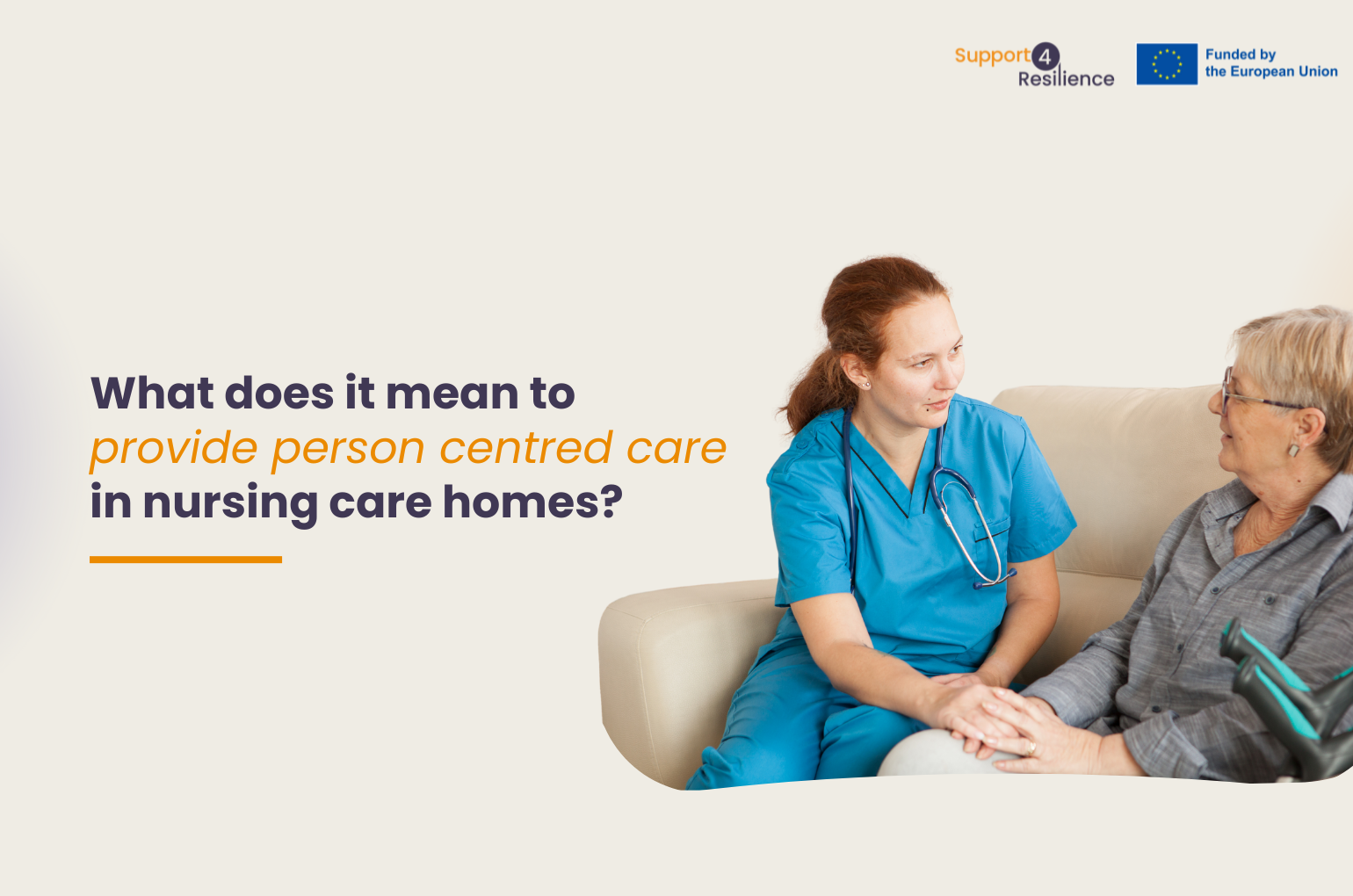How person centred care translates into day to day practice, the factors that make it possible, what is changing in Spain, and what we are learning with the Support4Resilience project.
How person centred care translates into day to day practice
You have probably heard the term “person centred care” (PCC). Over the past decades there has been an increased discussion around providing PPC (Ross et al., 2015). But what does it really mean when it comes to elderly people’s care?
The term was first used in the 60s by Edith Balint, a Hungarian psychiatrist who believed that patients should be seen as a whole-person (Santana et al., 2017). Today, the term PCC is often used to describe provision of healthcare services in a more personalised way, where the person (patient) and the healthcare provider can agree upon a specific healthcare plan (Byrne et al., 2020).
PCC in elderly care services
When it comes to caring for elderly people, the idea of a specific healthcare plan comes on a side. Instead, the central point of PCC in elderly care services is to provide care that responds to the needs of the elderly person, being these social or health related needs.
So, how can we ensure that elderly people’s needs are taken into account?
Key factors to bear in mind
Previous research (Ross et al., 2015) has shown that there are several key factors to bear in mind when looking at PCC in elderly care.
These include:
- Relationships between the different stakeholders in the care home.
- Involving the elder in decisions around his or her own care.
- The general work culture within the care home.
Spain’s new PCC model: the life goal interview
Spain is currently implementing a new PCC model (Oficina C, 2023). Following this model, the first step when elderly people enter a care home is to undertake a personal interview to find out what their life goal is.
Indeed, because even when people reach a very old age, they are still entitled to have their own goals in life. And care homes should be able to support them.
Nursing assistants as crucial stakeholders
As part of the S4R project, we have been conducting interviews with workers in nursing care homes in Spain. We have found out that there is another unrecognised key actor in this PCC plan: the nursing assistants! They are the closest link to the residents in care homes and those who spend most of the time with them. So, nursing assistants are a crucial stakeholder to support the elderly person’s life goal.
Day-to-day challenges in care homes
The way in which the current work is organised in many care homes, which are understaffed and with higher turnover rates, can make it challenging to support this PCC model. Tasks and tight schedules might prevail over opportunities to meet elderly’s needs, as previous research also described (Davies et al., 2022).
A helping hand might come along when actions aimed at increasing the resilience in healthcare are implemented, which is one of the main goals of the S4R project. Boosting resilience might require reframing current work practices to enable work teams to have the time, skills and resources to actually implement the PCC. And this could support increasing high quality in healthcare delivery (Ekman et al., 2021).
Measuring quality PCC today
Another question comes to mind. In current societies across Europe, where elderly people remain longer in their homes and in community settings (Oficina C, 2023), and also, where those entering nursing care homes have higher levels of dependency and chronic diseases, how can we measure quality PCC? And how can we ensure that the person’s needs and preferences are actually taken into account? A more interdisciplinary approach to integral care for the elderly might help in this sense.
Looking ahead: the S4R toolbox
We are eager to unveil the changes that the S4R toolbox will bring over the next few years to promote positive working environments for the elderly care workforce. The S4R toolbox is being specifically designed to promote resilience and wellbeing in the elderly care workforce so they can take care of our elderly people. Stay tuned!
Written by: Juana María Delgado-Saborit, Viola Cassetti, Estefanía Aparicio Llopis
and Isabel Almodóvar Fernández, from Universitat Jaume I.
References
Byrne, A. L., Baldwin, A., & Harvey, C. (2020). Whose centre is it anyway? Defining person-centred care in nursing: An integrative review. PLOS ONE, 15(3), e0229923. https://doi.org/10.1371/JOURNAL.PONE.0229923
Davies, M., Zúñiga, F., Verbeek, H., & Staudacher, S. (2022). Exploring resident experiences of person-centred care at mealtimes in long-term residential care: a rapid ethnography. BMC Geriatrics, 22(1), 1–12. https://doi.org/10.1186/S12877-022-03657-5/TABLES/1
Ekman, I., Ebrahimi, Z., & Olaya Contreras, P. (2021). Person-centred care: looking back, looking forward. European Journal of Cardiovascular Nursing, 20(2), 93–95. https://doi.org/10.1093/EURJCN/ZVAA025
Oficina de Ciencia y Tecnología del Congreso de los Diputados (Oficina C). (2023). Envejecimiento y bienestar. https://doi.org/10.57952/q3ze-2c39
Ross, H., Tod, A. M., & Clarke, A. (2015). Understanding and achieving person-centred care: The nurse perspective. Journal of Clinical Nursing, 24(9–10), 1223–1233. https://doi.org/10.1111/JOCN.12662
Santana, M. J., Manalili, K., Jolley, R. J., Zelinsky, S., Quan, H., & Lu, M. (2018). How to practice person-centred care: A conceptual framework. Health Expectations, 21(2), 429–440. https://doi.org/10.1111/HEX.12640

